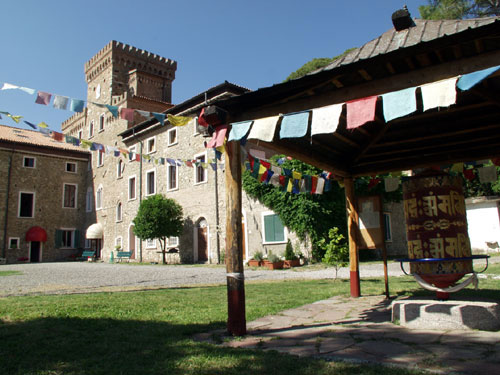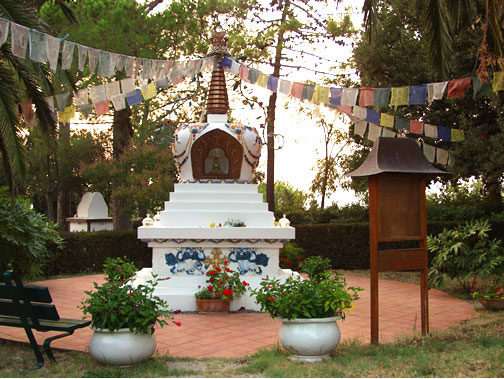
Lama Tzong Khapa Institute, Pomaia, Italy is one of the largest and most active Tibetan Buddhist Centers of the Gelug tradition in the Western world. Founded in 1977 by Lama Thubten Yeshe and Lama Zopa Rinpoche, it is a member of the Foundation for the Preservation of the Mahayana Tradition (FPMT) and the Italian Buddhist Union (UBI). It is particularly well known for the quality of its resident and visiting teachers as well as its structured study programs, the advanced level Masters Program in Buddhist Studies of Sutra and Tantra, the intermediate level Basic Program, and the introductory level Discovering Buddhism, as well as its year-round weekend Dharma courses. These programs are based on the authentic teachings of Buddha Shakyamuni, born 2500 years in India, as they were subsequently explained by Indian pandits, such as Nagarjuna, Chandrakirti, and Buddhapalita, and by Tibetan scholars, such as Lama Tsongkhapa, Jetsun Chogyi Gyeltsen, and others. Their unique purpose is to bring about a profound transformation of the person, leading to the culmination of the human qualities of love, compassion, and wisdom in the state of perfectly complete enlightenment or buddhahood.
In the spring of 1975, Claudio Cipullo, Piero Cerri and Massimo Corona each separately asked Lama Thubten Yeshe to come to teach in Italy during his second world tour; to each of them, he agreed. Returning to Italy several months later, they began working together to organize the first meditation course with Lama Yeshe and Lama Zopa Rinpoche in Italy. At that time Piero, already a monk, was staying in the entrance hall of a house sublet by a friend of his. This became their office. It was a bare, unfurnished room, with only a carpet on the floor and a telephone. From this office, they produced pamphlets and posters, pasting them up around town to announce the upcoming course.
This first course was held in a Roman Catholic retreat center in Eupilio, from October 13 – 20, 1975 and was attended by about eighty people. On October 19th, many of the participants at the course met with the organizers to discuss the possibility of establishing a center in Italy. They requested and received permission from Lama Yeshe to do so. Later that evening, towards midnight, after most of the participants had gone to their rooms, Peter Kedge, Lama Yeshe’s secretary, came to call Massimo, Piero and Claudio, saying, “Lama wants you in his room immediately.” When they entered his room Lama said, “I thought of a name for the center which will be established in Italy but, first of all, you have to tell me whether you really want it as in that case you will have to dedicate yourself one hundred percent to the center. That means that you will have to stop everything else that you are doing, because I need a total commitment from you.” The three promised their full commitment and Lama asked them to choose between two names for the new center: Lama Tsong Khapa or Atisha. Since they practiced the guru yoga of Lama Tsong Khapa, they chose to call the center by his name. Lama Yeshe also confirmed to them that he would have wanted to call it by the name of Je Rinpoche (i.e. Lama Tsong Khapa).
Lama then said, “Okay. Let’s decide together who will be responsible for the center and who will do what work. I say Massimo as director, Piero as spiritual director and Claudio as secretary. What do you say?” Then saying goodnight to Massimo, Piero and Claudio he also told them the essence of the significance of the center: “If the center becomes a type of soup, a type of samsaric game, then what would be the purpose of putting energy into this project? Why should you, why should I, put energy into it? We really don’t need to do that, don’t you think? In reality the true purpose of the center is to give us the possibility to serve. We are so lucky to have met the Mahayana dharma of Lord Buddha and we have to try to share this experience with others. Only for this purpose should the center be founded. So, my dears, okay. That’s all, dears, for this evening.”
The address of the new Institute was originally that of Massimo’s house in Via Papiniano, Milan, but in the summer of 1976 an apartment was rented in Via Ampere in order to organize the second course with the lamas. Piero and Claudio initiated regular activities, inviting Geshe Jampel Sangye and Geshe Rabten to give courses. This second course took place October 5 – 24, 1976 in Taceno, a small valley between Switerland and Lake Como, in an old hotel that had been closed for more than two years. With 24 hours of continuous work, several students cleaned and prepared the place for hosting the eighty participants, who came from all over Europe. Rinpoche taught Lam Rim and gave the 1000-Armed Chenrezig and Tara initiations. Lama gave refuge, precepts and the Vajrasattva initiation.
On the last day of the teaching, the students met with Lama to discuss finding a stable place for the Institute. Lama expressed very clear ideas regarding what kind of center should be established. He wanted it to be in the country and to be composed of a community of practicing students. It was to serve both as a base for the organization of courses, conferences and other activities that would be useful for making dharma teachings known to the public and as a center that would inspire the practice of dharma in Italy. His idea was that people living in the country far from the busy city, through helping each other, would progress more quickly in the practice of dharma. In this way, they would become an example and a guide to those interested in the teachings.
Lama wanted the place to have space for monks and nuns as well as single lay people and families. He said, “We have to build a mini-society in which these three types of individuals who have always formed the base for the spreading of the dharma in a country are present. The ordained and the lay people are to help each other in order to be able to create a suitable support for a Buddhist society. Ordained people alone or lay people alone cannot work.”
During this meeting, the administrators of the Institute agreed to work quickly to find a place within the following year. On November 17, 1976, Istituto Lama Tzong Khapa was registered as a cultural association, with Massimo Corona as president; in January 1977, Massimo began searching the length of Italy to find a suitable place to establish a community. Geshe Rabten suggested that Tuscany would be a good place to check and after looking at many houses, Massimo came to Pomaia. He immediately liked the large castle-style villa, set among the trees on top of a small hill overlooking the rolling countryside, and called Piero and Claudio to say that he had found a really beautiful house in the municipality of Santa Luce (“Holy Light” in Italian). Piero and Claudio traveled from Switzerland to see the place and thought it was perfect. They contacted Lama Yeshe, who gave his approval, and the first contract was signed in April 1977.
In May 1977, Geshe Rabten and Gonsar Rinpoche, after giving a course in Milan, came to Pomaia to bless the site. On arriving there, Gonsar Rinpoche pointed to the mountain behind the Institute and said that it was very auspicious, as its shape resembles that of an elephant. In June, the first residents moved in, although most of the building was still being rented by the previous owner since it had not yet been completely paid for. At that time, everyone worked in the Institute and paid for their own food and personal expenses. A gompa was set up in a room that is now used as a second dining room.
Lama Yeshe and Lama Zopa Rinpoche taught the third Italian meditation course in Pomaia that autumn and gave the community much-needed advice concerning what was involved in establishing a dharma center. Lama told them, “The purpose of the center is to serve others. This is an international center open to all people of any race, nationality or background. It is a place to learn how to train the mind in order to liberate it from deeply rooted harmful conceptions and thus to live in harmony with others by integrating one’s meditation practice in the work of everday life.”
In January 1978, the final contract with the previous owner of the building was signed and the community became completely dedicated to dharma activities as well as to the restoration of the main building and a house for resident and visiting teachers. The small group of residents worked hard, constructing a gompa, dormitories, a kitchen and bathrooms. At that time, a ruined building on the property was transformed into a small comfortable house (“the villetta”), with rooms upstairs for the resident geshe and His Holiness the Dalai Lama when he visited and a small apartment downstairs that was previously used by Lama Yeshe. This apartment is now used by Lama Zopa Rinpoche when he visits and by other visiting lamas and practitioners who want to do retreat. The residents worked tirelessly in the period before His Holiness’s first visit in 1982 in order to finish a major facelift to the exterior of the main building in time for his arrival.

Istituto Lama Tzong Khapa
Via Poggiberna, 9 Pomaia 56040 (Pisa) ITALY
Tel. 050.685654 – Fax 050.685695
Indirizzo ILTK di posta (generico): iltk@iltk.it
www.iltk.it




